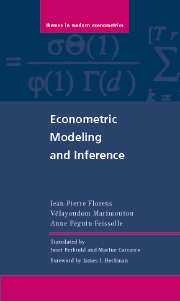Foreword
Summary
Jean-Pierre Florens, Vêlayoudom Marimoutou, and Anne Péguin-Feissolle have done economics a great service by writing this basic contribution to the teaching of econometrics. Econometrics is a major research tool for empirical economics. It unites economics with statistics and extends statistical methods to apply to economic problems and economic data.
Many introductory econometrics textbooks for graduate students have a cook-book quality. They summarize existing knowledge useful for particular problems without laying the foundations for extending existing knowledge. Rules are given without reasons and general principles. Readers who do not know the basic principles have trouble adapting existing knowledge to fit their application.
This book provides an introduction to current econometric knowledge that focuses on teaching the reader foundational statistical principles. It exposits the basic statistical principles underlying modern econometrics. This keeps alive and rejuvenates the tradition of Haavelmo (1944), who, in his Nobel Prize–winning contribution, first synthesized economic statistics with rigorous probability theory. It surveys a large array of econometric models and gives the reader the foundations required to adapt and extend those models to fit their applications. This book is wide ranging in that it covers classical econometric methods associated with linear regression and modern semiparametric cross-section and time series methods. It provides the reader with a useful introduction to a powerful set of tools and a guide to where to go to read the more advanced literature on a variety of topics useful in many fields of economics.
Information
- Type
- Chapter
- Information
- Econometric Modeling and Inference , pp. xvii - xviiiPublisher: Cambridge University PressPrint publication year: 2007
